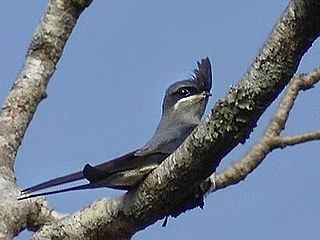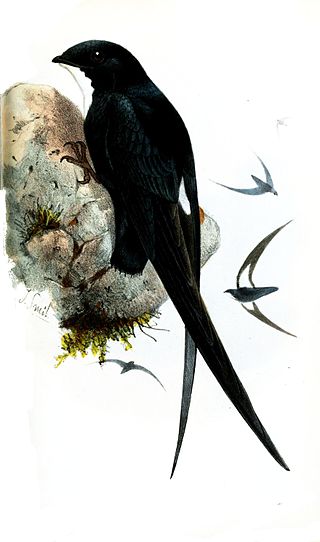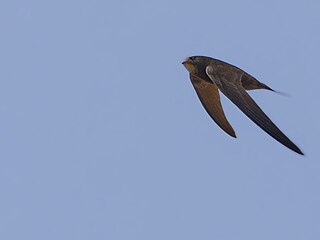
Traditionally, the bird order Apodiformes contained three living families: the swifts (Apodidae), the treeswifts (Hemiprocnidae), and the hummingbirds (Trochilidae). In the Sibley-Ahlquist taxonomy, this order is raised to a superorder Apodimorphae in which hummingbirds are separated as a new order, Trochiliformes. With nearly 450 species identified to date, they are the most diverse order of birds after the passerines.

The swifts are a family, Apodidae, of highly aerial birds. They are superficially similar to swallows, but are not closely related to any passerine species. Swifts are placed in the order Apodiformes with hummingbirds. The treeswifts are closely related to the true swifts, but form a separate family, the Hemiprocnidae.

Treeswifts or crested swifts are a family, the Hemiprocnidae, of aerial near passerine birds, closely related to the true swifts. The family contains a single genus, Hemiprocne, with four species. They are distributed from India and Southeast Asia through Indonesia to New Guinea and the Solomon Islands.

The crested treeswift is a species of tree swift. It was for some time considered the same species as its eastern relative, the gray-rumped treeswift, but they do not interbreed where their ranges overlap. It is distinct in flight, with long, bowed wings and a deeply forked tail that usually appears narrow and pointed.

The white-rumped spinetail or white-rumped needletail is a species of swift found in the forests of Bangladesh, India and Nepal. It is often seen over waterbodies in the middle of forest. It can resemble a house swift but has a white vent.

Mearnsia is a genus of swifts in the family Apodidae.

Böhm's spinetail, also Bohm's spinetail or Boehm's spinetail,, also known as the bat-like spinetail, is a species of swift in the family Apodidae.

Panyptila is a genus of swifts in the family Apodidae. The two species are found in Central and South America.

The scarce swift is a species of swift in the family Apodidae. It has a disjunct range of presence throughout the Afromontane : Cameroon line, Albertine Rift montane forests, Kenya, Tanzania, Malawi and Mozambique.

The mottled swift is a species of bird in the swift family, Apodidae. It is one of two species in the genus Tachymarptis together with the alpine swift. It occurs widely in eastern Africa and locally in western Africa. It is found in Angola, Burkina Faso, Burundi, Cameroon, Central African Republic, Chad, Democratic Republic of the Congo, Ivory Coast, Eritrea, Ethiopia, Gabon, Ghana, Guinea, Kenya, Malawi, Mali, Mozambique, Nigeria, Rwanda, Sierra Leone, Sudan, Tanzania, Togo, Uganda, Zambia, and Zimbabwe.

Telacanthura is a genus of swift in the family Apodidae. It contains the following species:
The Madagascar spinetail, Madagascan spinetail or Malagasy spinetail is a species of swift in the family Apodidae. It is found in Comoros, Madagascar, and Mayotte.

The São Tomé spinetail is a species of swift in the family Apodidae. It is endemic to São Tomé and Príncipe. The species was described by Ernst Hartert on 1900.

The whiskered treeswift is a species of bird in the family Hemiprocnidae. It is the smallest of 4 species in genus Hemiprocne and is found in Brunei, Indonesia, Malaysia, Myanmar, the Philippines, Singapore, and Thailand.

The grey-rumped treeswift is a species of bird in the Hemiprocnidae family. Currently, four extant species are placed in the family. Like the other members of the Hemiprocnidae, this species is closely related to true swifts, but unlike true swifts, the treeswifts are arboreal in nature, often seen perched on trees and high-tension power transmission lines, and on pylons. When perched, the wing tips cross over the tail. This species is commonly found in peninsular Malaysia, but has an extremely large range with limited information about the population trend,.
Spinetail can refer to birds of several genera:

Apodimorphae is a clade of strisorean birds that include the extant families Trochilidae (hummingbirds), Hemiprocnidae (treeswifts), Apodidae (swifts), and Aegothelidae (owlet-nightjars), as well as many fossil families. This grouping of birds has been supported in a variety of recent studies. There are two higher classification schemes that have been proposed for the apodimorph families. One is all strisorean birds are classified in the order Caprimulgiformes, while the other is the strisorean birds are split into several distinct orders. In this case Apodimorphae is a subclade of Strisores that includes the orders Aegotheliformes and the Apodiformes. A similar name for the group Daedalornithes has been used for the owlet-night-apodiform clade, there is a difference between the two names with Apodimorphae defined as the total-group and Daedalornithes defined as the crown group.

The Apodinae are a subfamily of swifts and contain the following species:
Thomensis is Latin for "of Thomas" or "of the island of São Tomé". It may refer to several species found on the island and in the surrounding waters:















